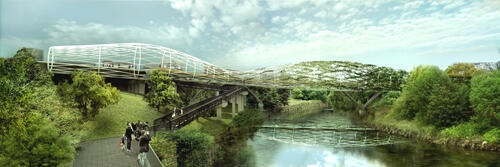 BACK TO HOMEPAGE >
BACK TO HOMEPAGE >

Salford Meadows Bridge Competition | London, United Kingdom | 2013
Architects: Standard
Client: Royal Institute of British Architects
Photographer: Images by Standard
The new Salford Meadows bridge forms a landmark node near the Crescent-Oldfield Road intersection; it synthesizes the existing improvements and brings the Meadow to the city.
Elongating and curving the bridge places the city landing at the bus stop, and allows the bridge to meet the Meadow without mounding. The new bridge is a timber pathway wrapped in a lattice shell tunnel that varies in section, planted at the meadow side with Virginia Creeper.
Over time, the bridge will become grown over, creating a dramatic transition to from the city to the Meadow. The lattice shell is visible from the intersection of Oldfield Road, and the structure envelops the passersby as they move along the sidewalk.
The bridge replaces the existing pergola and bus shelter with a single element - a grand enclosure that invites discovery. The bridge bends toward the east, bringing the Crescent landing is closer to the pedestrian crossing at Oldfield Road, and pulling pedestrian traffic into the Meadow.
Elongating and curving the bridge preserves the topography of the Meadow with an at-grade landing. The lower mouth of the bridge peeks through the trees bordering the Meadow, burrow-like, a modest but identifiable presence at the meadow's edge.
The timber-clad walking path 'floats' within the lattice tunnel, making the walk through the bridge a spatial experience. The voluminous passageway varies in diameter, creating a variety of experience through movement. Vines growing on the shell change color with the seasons, adding another dimension to the walk. Structural Concept Primary structure at the spans are HEB550 beams under the walkway; the secondary members are the hoops and lattice shell constructed with hollow steel sections. The hoops and lattice shell are connected to the webs of the HEB members, providing lateral stiffness and the necessary resistance to vibration. The walking path is constructed with smaller steel members clad in timber.


